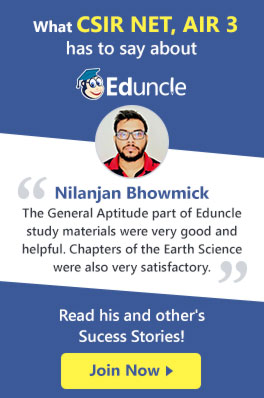Time management is very much important in IIT JAM. The eduncle test series for IIT JAM Mathematical Statistics helped me a lot in this portion. I am very thankful to the test series I bought from eduncle.
Nilanjan Bhowmick AIR 3, CSIR NET (Earth Science)- CSIR NET
- Life Sciences
What is microtome ?what its uses ?how it is useful?how to handle it ?
what is Microtome ?what its uses ?how it is useful?how to handle it ?
1 Answer(s)
Answer Now
- 0 Likes
- 1 Comments
- 0 Shares
-
D
T
Do You Want Better RANK in Your Exam?
Start Your Preparations with Eduncle’s FREE Study Material
- Updated Syllabus, Paper Pattern & Full Exam Details
- Sample Theory of Most Important Topic
- Model Test Paper with Detailed Solutions
- Last 5 Years Question Papers & Answers
Sign Up to Download FREE Study Material Worth Rs. 500/-

















Dr. sonal singh 1![best-answer]()
MICROTOME- A microtome (from the Greek mikros, meaning "small", and temnein, meaning "to cut") is a cutting tool used to produce extremely thin slices of material known as sections. Important in science, microtomes are used in microscopy, allowing for the prepartion of samples for observation under transmitted light or electron radiation. Microtomes use steel, glass or diamond blades depending upon the specimen being sliced and the desired thickness of the sections being cut. Steel blades are used to prepare histological sections of animal or plant tissues for light microscopy. Glass knives are used to slice sections for light microscopy and to slice very thin sections for electron microscopy. Industrial grade diamond knives are used to slice hard materials such as bone, teeth and tough plant matter for both light microscopy and for electron microscopy. Gem-quality diamond knives are also used for slicing thin sections for electron microscopy. Microtomy is a method for the preparation of thin sections for materials such as bones, minerals and teeth, and an alternative to electroploishing and ion milling. Microtome sections can be made thin enough to section a human hair across its breadth, with section thickness between 50 nm and 100 micron. HOW TO HANDLE IT ALONGWITH USES and USEFULNESS- Different procedures of handling of a microtome and uses Traditional histology Technique: Tissues are fixed, dehydrated, cleared, and embedded in melted paraffin, which when cooled forms a solid block. The tissue is then cut in the microtome at thicknesses varying from 2 to 50 μm. From there the tissue can be mounted on a microscope slide, stained with appropriate aqueous dye(s) after removal of the paraffin, and examined using a light microscope.: Tissues are fixed, dehydrated, cleared, and embedded in melted paraffin, which when cooled forms a solid block. The tissue is then cut in the microtome at thicknesses varying from 2 to 50 μm. From there the tissue can be mounted on a microscope slide, stained with appropriate aqueous dye(s) after removal of the paraffin, and examined using a light microscope. FROZEN SECTION TECHNIQUE- Water-rich tissues are hardened by freezing and cut in the frozen state with a freezing microtome or microtome-cryostat; sections are stained and examined with a light microscope. This technique is much faster than traditional histology (5 minutes vs 16 hours) and is used in conjunction with medical procedures to achieve a quick diagnosis. Cryosections can also be used in immunochemistry as freezing tissue stops degradation of tissue faster than using a fixative and does not alter or mask its chemical composition as much. ELECTRON MICROSCOPY TECHNIQUE- After embedding tissues in epoxy resin, a microtome equipped with a glass or gem grade diamond knife is used to cut very thin sections (typically 60 to 100 nanometer). Sections are stained with an aqueous solution of an appropriate heavy metal salt and examined with a transmission electron microscope. This instrument is often called an ultramicrotome. The ultramicrotome is also used with its glass knife or an industrial grade diamond knife to cut survey sections prior to thin sectioning. These survey sections are generally 0.5 to 1 μm thick and are mounted on a glass slide and stained to locate areas of interest under a light microscope prior to thin sectioning for the TEM. Thin sectioning for the TEM is often done with a gem quality diamond knife. Complementing traditional TEM techniques ultramicrotomes are increasingly found mounted inside an SEM chamber so the surface of the block face can be imaged and then removed with the microtome to uncover the next surface for imaging. This technique is called SERIAL BLOCK FACE SCANNING ELECTRON MICROSCOPY (SBFSEM). Botanical Microtomy Technique: hard materials like wood, bone and leather require a sledge microtome. These microtomes have heavier blades and cannot cut as thin as a regular microtome. Spectroscopy (especially FTIR or Infrared spectroscopy) Technique: thin polymer sections are needed in order that the infra-red beam will penetrate the sample under examination. It is normal to cut samples to between 20 and 100 μm in thickness. For more detailed analysis of much smaller areas in a thin section, FTIR can be used for sample inspection. A recent development is the laser microtome, which cuts the target specimen with a femtosecond laser instead of a mechanical knife. This method is contact-free and does not require sample preparation techniques. The laser microtome has the ability to slice almost every tissue in its native state. Depending on the material being processed, slice thicknesses of 10 to 100 μm are feasible.